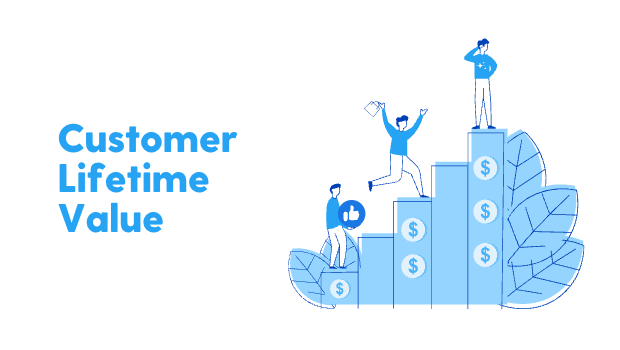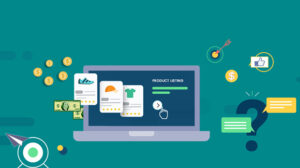Customer Lifetime Value (CLV or CLTV) is a prediction of the total amount of money a customer will spend on a business’s products or services over the course of their relationship with the business.
It is an important metric for businesses to track because it can help understand the profitability of their customer base and make informed decisions about how much to invest in acquiring and retaining customers. By understanding CLV, businesses can set customer acquisition and retention goals, price their products and services appropriately, and identify profitable customer segments.
How to calculate Customer Lifetime Value (CLV)
There are several different methods that businesses can use to calculate Customer Lifetime Value (CLV). Here are three common methods:
- The Single Period Method: The single period method calculates CLV based on a single period of time, such as a year or a month. To calculate CLV using this method, businesses need to gather data on customer purchases and behavior, including the average order value, the number of purchases per period, and the average customer lifespan. They can then use the following formula to calculate CLV:CLV = (Average Order Value x Number of Purchases per Period) x Average Customer Lifespan
- The Multiple Period Method: The multiple period method calculates CLV over multiple periods of time, such as multiple years. To calculate CLV using this method, businesses need to gather data on customer purchases and behavior, including the average purchase value, the number of purchases per period, and the average customer lifespan. They can then use the following formula to calculate CLV:CLV = (Average Purchase Value x Number of Purchases per Period) x (1 + Discount Rate)^Number of Periods
- The Discounted Cash Flow Method: The discounted cash flow method calculates CLV by discounting future cash flows to present value. Determine an appropriate discount rate to use in the calculations and use the following formula to calculate CLV:CLV = (Average Purchase Value x Number of Purchases per Period) / Discount Rate
Each of these methods has its own strengths and limitations, and businesses should choose the method that best fits their needs and goals.
Another way to measure CLV:
CLV = (Average Order Value x Purchase Frequency)/(1 – Customer Churn Rate)
where:
- Average Order Value (AOV) is the average amount of money a customer spends per order
- Purchase Frequency is the number of times a customer makes a purchase in a given period (e.g., per year)
- Customer Churn Rate is the percentage of customers who stop making purchases over a given period
For example, let’s say a business has an AOV of $50, a purchase frequency of 2 orders per year, and a customer churn rate of 5%. Using the above formula, the CLV for this business would be:
CLV = ($50 x 2)/(1 – 0.05) = $100
This means that, on average, a customer of this business is expected to spend $100 over their lifetime.
Factors to Consider while Calculating CLV
- Customer value drivers: To accurately calculate CLV, businesses need to consider the factors that drive customer value. These can include the average purchase value, the frequency of purchases, and the customer lifespan, as well as other factors such as customer loyalty and referrals.
- Data quality and accuracy: Accurate data is essential for calculating CLV. To ensure the quality and accuracy of the data used in their calculations, businesses should use reliable sources and double-check their data for errors or discrepancies.
- Changing customer behavior: It’s important to note that customer behavior can change over time, which can impact CLV. To account for changes in customer behavior, businesses should regularly review and update their CLV calculations.
- Other factors to consider: There are many other factors that can impact CLV, such as marketing and sales efforts, changes in the competitive landscape, and economic conditions. Businesses should consider these factors when calculating CLV and make adjustments as needed.
It’s important to note that CLV is a prediction, and it can be difficult to accurately predict the exact CLV for an individual customer. However, by tracking CLV for different customer segments, a business can get a sense of the overall value of its customer base, and make informed decisions.
For businesses that have recurring revenue streams, such as subscription-based businesses, Recurring Lifetime Value (LTV) can be calculated by multiplying the average monthly revenue per customer by the number of months that the customer is expected to remain a customer. It can also be useful for businesses with one-time sales, as it can help to identify high-value customers and target them for upselling or cross-selling opportunities.
Also, read:
Using CLV to Inform Business Decisions
Here are 10 ways in which businesses can use CLV to inform their decision making:
- Setting customer acquisition and retention goals: By understanding CLV, businesses can set customer acquisition and retention goals that are aligned with their overall business objectives. For example, if a business has a high CLV, it may set a goal of acquiring as many new customers as possible, while if it has a low CLV, it may focus more on retaining existing customers.
- Identifying profitable customer segments: CLV can also help businesses identify profitable customer segments and tailor their marketing efforts to target these segments. By understanding which segments are most valuable to the business, businesses can allocate their marketing resources more effectively.
- Subscription eCommerce: A subscription ecommerce business, such as a monthly snack box company, can use CLV to determine how much they can afford to spend on acquiring new subscribers. If the average CLV of a subscriber is $100 and the business’s customer acquisition cost (CAC) is $50, they can afford to acquire new subscribers because they will eventually make back the cost of acquisition through the customer’s lifetime value.
- Marketing campaigns: A business can use CLV to inform their marketing campaign budgets. If the CLV of a customer is high, the business can afford to spend more on acquiring that customer because they will likely generate more revenue over their lifetime.
- Product development: A business can use CLV to prioritize which products or features to develop. If a particular product has a higher CLV, the business may want to allocate more resources towards developing and promoting that product.
- Customer service: A business can use CLV to justify investing in high-quality customer service. If a business knows that providing excellent customer service can lead to increased customer loyalty and a higher CLV, they may be willing to invest more in training and support for their customer service team.
- Pricing strategy: A business can use CLV to determine the optimal price for their products or services. If the CLV is high, the business may be able to increase their prices without losing too many customers because the customer is willing to pay more for the value they receive. On the other hand, if the CLV is low, the business may need to lower their prices in order to be competitive and attract more customers.
- Sales strategy: A business can use CLV to inform their sales strategy, such as which customers to target or which upsell or cross-sell opportunities to pursue. If a business knows that certain customers have a higher CLV, they may want to prioritize selling to those customers or finding ways to increase the amount of money those customers spend over time.
- Retention efforts: A business can use CLV to identify which customers are most valuable and prioritize retention efforts accordingly. For example, a business may want to offer additional incentives or perks to their high-CLV customers to encourage them to continue doing business with the company.
- Resource allocation: A business can use CLV to determine how to allocate their resources, such as which channels to focus on for customer acquisition or which customer segments to target. For example, if a business finds that their CLV is higher for customers acquired through certain marketing channels, they may want to allocate more resources towards those channels.
Also, read:
Best Practices for Maximizing CLV
11 ways in which brands can maximize their CLV:
- Offering personalized experiences: Personalizing the customer experience helps to maximize CLV. By tailoring products, services, and marketing efforts to meet the specific needs and preferences of individual customers, businesses can increase customer satisfaction and loyalty. Read more – Experiential Marketing
- Offer a high-quality product or service: This is the foundation of any successful business. By offering a product or service that meets the needs and expectations of customers, businesses can build customer loyalty and increase CLV.
- Foster customer loyalty: One way to increase CLV is to make it easy for customers to stay with the business. This can be achieved through loyalty programs, personalized communication, and excellent customer service.
- Upsell and cross-sell: Offering related products or services to customers can increase their lifetime value by encouraging them to purchase more from the business. For example, a subscription box company could offer additional boxes or single item purchases to their subscribers.
- Increase customer retention: Keeping customers around for longer periods of time can significantly increase CLV. This can be achieved through excellent customer service, regular communication, and providing value through the product or service.
- Expand the customer base: By attracting new customers, businesses can increase the overall size of their customer base and therefore increase CLV. This can be done through targeted marketing efforts and providing an excellent customer experience to drive word-of-mouth referrals.
- Offer flexible pricing options: Giving customers the ability to customize their subscription or purchase plans can make the business more appealing and increase CLV. For example, a coffee subscription service could offer different frequency options (weekly, monthly, etc.) and allow customers to choose the types of coffee they receive.
- Provide excellent customer support: Customers are more likely to continue doing business with a company that provides excellent support. By offering fast and helpful support, businesses can increase customer satisfaction and retention, leading to higher CLV.
- Continuously improve the product or service: Keeping the product or service up-to-date and relevant can help to maintain customer interest and increase CLV. This can be achieved through regular product updates, new features, and gathering customer feedback to understand what they want and need.
- Encourage customer feedback and act on it: Gathering and acting on customer feedback can help businesses improve their product or service and increase customer satisfaction, leading to higher CLV.
- Create a sense of community: Building a sense of community among customers can increase loyalty and retention, leading to higher CLV. This can be achieved through social media groups, online forums, and in-person events. Read more – Social Commerce
Why Turnkey Tools Fail to Accurately Measure CLV
Challenges in tracking and measuring CLV include:
- Incomplete data: CLV calculations require a comprehensive and accurate data set to be effective. If a turnkey tool is not collecting data from all relevant channels and touchpoints, it may not have a complete picture of the customer journey and could provide an inaccurate CLV. A data warehouse-led approach is most efficient for most businesses.
- Incorrect assumptions: CLV calculations often involve making assumptions about customer behavior, such as retention rates and purchase frequency. If these assumptions are incorrect, it can lead to an inaccurate CLV.
- Changes in customer behavior: CLV is a predictive metric, so it relies on historical data to make predictions about the future. If a business’s customer base changes significantly over time (e.g. due to changes in the market or the business’s product or service offerings), it can make it difficult for a turnkey tool to accurately predict CLV.
- Complex customer journeys: If a business’s customers follow a complex path to purchase (e.g. with multiple touchpoints and channels), it can be difficult for a turnkey tool to accurately attribute value to each step in the journey and accurately calculate CLV. Read more – Customer Journey Mapping
- Lack of customization: Turnkey tools are designed to be easy to use and require minimal setup, but this can also be a limitation. If a business has unique needs or wants to track custom metrics, a turnkey tool may not be able to accommodate these requirements and could provide an inaccurate CLV.
- Lack of integration with other systems: If a business is using multiple systems to track different aspects of the customer journey (e.g. a CRM system and a marketing automation platform), a turnkey tool may not be able to integrate data from these systems and could provide an incomplete or inaccurate CLV.
Overall, while turnkey tools like Lifetimely.io can be a useful short-term way for measuring CLV, they may not be suitable for all businesses, particularly those with complex omnichannel customer journeys or unique tracking requirements. In these cases, businesses may need to consider more customizable and comprehensive tracking solutions.
To overcome these challenges, businesses can implement robust tracking systems and regularly review and update their CLV calculations to ensure that they accurately reflect the current state of the business.
Conclusion
CLV is a valuable metric for businesses to understand, as it can help them determine how much they can afford to spend on acquiring new customers and how much they should invest in retaining existing ones. By calculating CLV and using it to inform business decisions, businesses can set customer acquisition and retention goals, price their products and services appropriately, and identify profitable customer segments.
To start incorporating CLV into their decision-making processes, businesses can begin by gathering data on customer purchases and behavior and using this data to calculate CLV. They can then use CLV to inform their customer acquisition and retention strategies and to optimize pricing and marketing efforts. Finally, they can implement best practices for maximizing CLV, such as providing excellent customer service and offering personalized experiences, to drive customer loyalty and retention.
Implementing Google Analytics 4 (GA4) and a data warehouse can be a powerful solution for tracking and maximizing customer lifetime value (CLV) and other relevant metrics. With GA4, you can track customer interactions across all channels and devices, providing a more complete view of the customer journey. A data warehouse allows you to store, organize, and analyze large amounts of data from multiple sources, including GA4. This enables you to gain insights into customer behavior, preferences, and trends, and use this information to optimize your marketing and sales efforts. By working with Saras Analytics to set up GA4, a data warehouse and automated reporting dashboards end-to-end, you can benefit from our managed data service and expertise in working with over 2000 eCommerce brands. This can help you get the most out of these powerful tools and make informed decisions to drive business growth.













